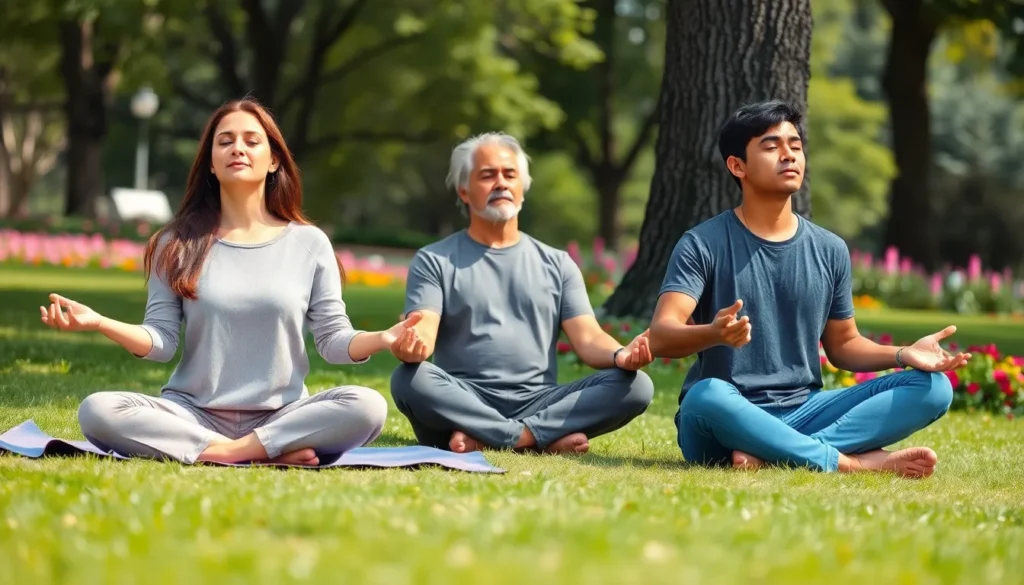Table of Contents
ToggleIn a world where stress seems to be the uninvited guest at every gathering, finding a way to kick it out can feel like a full-time job. Enter mindfulness, the superhero of stress relief, swooping in to save the day without a cape or tights. It’s all about being present and fully engaged in the moment, which sounds simple but can work wonders for the frazzled mind.
Imagine sipping your morning coffee while actually tasting it instead of worrying about that email you forgot to send. Mindfulness isn’t just a buzzword; it’s a powerful tool that can transform chaos into calm. Whether you’re juggling deadlines or dealing with life’s curveballs, practicing mindfulness can help you hit a home run in stress relief. Let’s dive into how this simple practice can turn your stress into serenity, one deep breath at a time.
Understanding Mindfulness
Mindfulness serves as an essential approach for stress relief. It emphasizes staying present and engaged, allowing individuals to navigate life’s pressures more effectively.
Definition of Mindfulness
Mindfulness refers to the practice of focusing on the present moment without judgment. Attention centers on thoughts, feelings, and sensations as they occur. It encourages individuals to observe their experiences openly. Research indicates that consistent practice enhances emotional regulation. Mindfulness fosters awareness, helping people break free from automatic reactions. Techniques include breathing exercises, meditation, and simple observations. Practicing mindfulness often leads to a greater sense of calm and well-being.
Origins and History
Mindfulness traces its roots to ancient Eastern philosophies, particularly Buddhism. Historical texts document its use in meditation practices over 2,500 years ago. Western interest in mindfulness grew in the late 20th century. Jon Kabat-Zinn introduced mindfulness-based stress reduction (MBSR) in 1979, which combined traditional practices with modern science. His work popularized mindfulness in clinical settings, demonstrating its effectiveness for stress and anxiety. Today, mindfulness appears in various therapeutic practices and wellness programs, gaining recognition for its benefits in mental health.
Benefits of Mindfulness for Stress Relief

Mindfulness offers multiple benefits that enhance overall well-being and reduce stress. Engaging in mindfulness practices allows individuals to experience significant psychological and physical improvements.
Psychological Benefits
Mindfulness fosters emotional regulation, allowing individuals to better manage anxiety and depression. It enhances self-awareness, leading to improved responses to stress. Feeling more present reduces negative thought patterns, contributing to greater peace of mind. Individuals who practice mindfulness report experiencing increased resilience against stress. This practice helps individuals cultivate a positive mindset, making them more adept at handling life’s challenges.
Physical Health Improvements
Practicing mindfulness can lead to lower cortisol levels, the hormone associated with stress. Stress reduction often results in improved sleep quality and duration. It can enhance immune function, making the body more resistant to illnesses. Already, studies show that individuals practicing mindfulness experience decreased blood pressure and improved heart health. Overall, mindfulness contributes to a more balanced and healthier lifestyle.
Techniques for Practicing Mindfulness
Practicing mindfulness involves various techniques that promote presence and awareness. Three widely recognized methods include mindfulness meditation, breathing exercises, and the body scan technique.
Mindfulness Meditation
Mindfulness meditation involves focusing on thoughts and sensations without judgment. Participants often start by finding a quiet space and sitting comfortably. Concentration typically centers on the breath, allowing fluctuations in thoughts to pass without engagement. This practice encourages a deeper connection to the present moment, facilitating emotional regulation. Research shows mindfulness meditation can lead to reduced anxiety and improved overall well-being.
Breathing Exercises
Breathing exercises enhance mindfulness by directing attention to the breath. Simple techniques, such as deep abdominal breathing, significantly calm the nervous system. Individuals take slow, deep breaths, inhaling through the nose for a count of four, holding for four, and exhaling through the mouth for another four counts. Regular practice lowers stress levels and cultivates a sense of grounding. Studies indicate that controlled breathing can reduce cortisol levels and improve sleep quality, reinforcing its efficacy for stress relief.
Body Scan Technique
The body scan technique promotes body awareness and relaxation. Participants typically lie down in a comfortable position and systematically focus on different body parts. Starting from the toes and moving to the head, individuals observe sensations without judgment. This approach fosters connection with physical experiences and encourages letting go of tension. Evidence suggests that body scanning can help alleviate stress and enhance emotional well-being by encouraging acceptance and awareness of bodily sensations.
Integrating Mindfulness into Daily Life
Incorporating mindfulness into daily activities promotes a sense of calm and focus. The following practices illustrate how simple adjustments can enhance the quality of everyday experiences.
Mindful Eating
Mindful eating encourages awareness during meals. Focusing on flavors, textures, and the act of chewing enhances the dining experience. Individuals notice their body’s hunger and fullness cues better, which can prevent overeating. Eating slowly allows savoring each bite, promoting appreciation for food. This practice not only enriches the meal but also fosters healthier eating habits.
Mindful Walking
Mindful walking transforms a common activity into a meditative practice. Paying attention to each step and surrounding sensations encourages presence in the moment. Individuals observe their breath and engage with the environment, noticing sights, sounds, and smells. This simple act reduces stress and boosts mood. Walking mindfully provides an opportunity to reconnect with the body and nature, promoting overall well-being.
Creating a Mindfulness Routine
Establishing a mindfulness routine facilitates consistent practice. Setting aside specific times each day for mindfulness activities reinforces commitment. Individuals might incorporate short meditation sessions or breathing exercises after waking or before bed. Journaling thoughts and reflections can deepen awareness and self-understanding. Building this routine helps integrate mindfulness into life, making it an essential part of daily habits.
Embracing mindfulness can significantly enhance one’s ability to manage stress and cultivate a sense of tranquility. By focusing on the present moment individuals can break free from the cycle of anxiety and overwhelm. Simple practices like deep breathing and mindful eating not only improve emotional well-being but also promote physical health.
Incorporating mindfulness into daily routines fosters resilience and helps create a balanced lifestyle. As people navigate the challenges of modern life they can find solace in the transformative power of being present. Making mindfulness a priority can lead to lasting benefits that enrich both mental and physical health.




